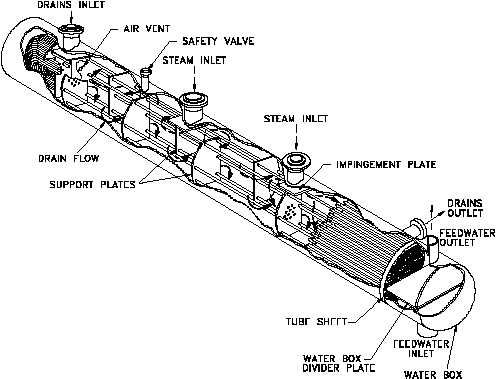Heat Exchangers
DOE-HDBK-1018/1-93
TYPES OF HEAT EXCHANGERS
Plate
Figure 1 Tube and Shell Heat Exchanger
A plate type heat exchanger, as illustrated in Figure 2, consists of plates instead of tubes
to separate the hot and cold fluids. The hot and cold fluids alternate between each of the
plates. Baffles direct the flow of fluid between plates. Because each of the plates has
a very large surface area, the plates provide each of the fluids with an extremely large
heat transfer area. Therefore a plate type heat exchanger, as compared to a similarly
sized tube and shell heat exchanger, is capable of transferring much more heat. This is
due to the larger area the plates provide over tubes. Due to the high heat transfer
efficiency of the plates, plate type heat exchangers are usually very small when compared
to a tube and shell type heat exchanger with the same heat transfer capacity. Plate type
heat exchangers are not widely used because of the inability to reliably seal the large
gaskets between each of the plates. Because of this problem, plate type heat exchangers
have only been used in small, low pressure applications such as on oil coolers for
engines. However, new improvements in gasket design and overall heat exchanger
design have allowed some large scale applications of the plate type heat exchanger. As
older facilities are upgraded or newly designed facilities are built, large plate type heat
exchangers are replacing tube and shell heat exchangers and becoming more common.
Rev. 0
ME-02
Page 3

